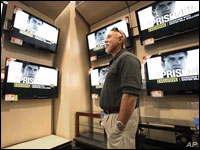
This story was originally published on Nov. 20, 2012, and is brought to you today as part of our Best of ECT News series.
How can classic retail, the brick-and-mortar physical stores dotting ourneighborhoods, compete with the likes of Amazon and Zappos? Can real-world retail survive e-commerce? And if it can, what’s the trick? How do retailers intend to meet this growing threat?
From the outside, shopping malls do not exist, author Douglas Coupland wrote in his visionary 1991 novel, Generation X: Tales for an Accelerated Culture. Consumers consider malls real from the inside only. Those giant, monolithic blocks squatting in the midst of neighborhoods aren’t really there.
That is to say, the outside of the mall is irrelevant, maintained Coupland — unlike classic, important communal architecture like a cathedral, for example. From society’s point-of-view, the important things — the stuff you can buy and the opportunities for social interaction — are inside.
When Coupland first introduced the concept, the neologism was “the emperor’s new mall.” More than 20 years have gone by since he wrote that book, and we’ve seen plenty of changes in mall culture since then, including the rise of the pile-’em-high discounter box store, the slicing-off of the roof, and the creation of fountain-spurting outdoor promenade-style malls — even some glassy buildings of architectural merit. If he’d written Generation X today, Coupland may have called it “architectural indigestion.”
However, we’re now also seeing something insidious that threatens the very heart of even Coupland’s cynical view of the mall — something so prevalent this year that it even has its own neologism: showrooming.
Pocket Shopper
Showrooming is the practice of visiting a store to look at an item, but then buying it somewhere else — usually from an online source in competition with a brick-and-mortar outlet.
The product resides at an unassociated fulfillment warehouse, likely at the junction of a couple of freeways in the middle of the desert, rather than a classic store. This practice turns the mall — or its sister, the big box store — into nothing more than a place to inspect and compare items before ordering them online.
We’re talking about rampant, smartphone-driven price-comparisons.
As we enter retail’s peak season, it’s a good time to search for some answers to where brick-and-mortar retail is headed, and explore how retail can deal with this problem.
“Showrooming is all about price,” Greg Petro, CEO of retail analytics provider First Insight, told the E-Commerce Times.
Up to 59 percent of U.S. smartphone owners practice showrooming, Petro reckons. However, on-the-fly price-matching isn’t the answer, in his view — retailers can address the problem by setting the prices correctly to begin with.
Big Box store retailers Best Buy and Target have said they will match prices with online retailers this season. Although it’s a short-term solution, price-matching creates an environment where the consumer knows the retailer will always lower the price, thus removing the retailer’s negotiating position, Petra noted.
“Price matching is a short-term fix to a bigger challenge — that of getting the productpriced correctly from the outset. Once you have the customer in your store, if you haveset prices right from the start, the need to price-match is greatly reduced,” he said.
If the prices are right, the retailer can make the sale, Petro noted, as the shopper is already in the store.
Combatting Showrooming
IKEA has taken a different tack to combat the problem of third-party online sales cannibalizing its brick-and-mortar operations. It’s trying to get the customer to make a decision at home, before going shopping.
“Just because a classic retailer is confined to their brick-and-mortar location to sell products doesn’t mean that their marketing has to operate within the same constraints,” Phil Edelstein, manager of brand strategy at Brownstein Group, told the E-Commerce times.
The idea behind IKEA’s interactive, Web-based seasonal catalog, produced by Brownstein Group, is to bring the in-store experience to life online. It allows shoppers to interact with room settings and products.
“It offers an interactive way for customers to engage with the brand, create a shopping list that drives in-store sales, and share products via social media,” Edelstein said.
The Chains
Some carnage is already apparent this holiday. This week, JC Penney announced a third consecutive quarterly loss, missing Wall Street estimates. The company had junked coupons and numerous sales earlier this year, and customers didn’t like it.
How are those chains approaching the problem?
Walmart’s Mobile Answer
Walmart has not seen the same kinds of sales problems as JC Penney, and market analysts are bullish about its prospects, partly because of an increased focus on online sales. Walmart is driving those sales, in part, through a unique smartphone app:
“Walmart’s iPhone app recognizes when customers are in our stores, and changes its interface to features designed to help customers shop our physical stores,” Ravi Jariwala, director of public relations, told the E-Commerce Times.
The app lets them view local advertisements, see local store prices, and see actual aisle location of products carried in local stores. Walmart calls it “in-store mode,” and Jariwala reckons his company is the only major retailer to offer it across all stores in the U.S.
The Outlook
“Retailers have to find a way to take the brand experience they create in their stores and replicate and amplify that experience online,” said the Brownstein Group’s Edelstein.
“This becomes especially important,” he said, “when they are facing many e-commerce competitors who are dominating the digital landscape.”










































Social Media
See all Social Media